Letermovir
Editor-In-Chief: C. Michael Gibson, M.S., M.D. [1]; Associate Editor(s)-in-Chief: Sonya Gelfand
Disclaimer
WikiDoc MAKES NO GUARANTEE OF VALIDITY. WikiDoc is not a professional health care provider, nor is it a suitable replacement for a licensed healthcare provider. WikiDoc is intended to be an educational tool, not a tool for any form of healthcare delivery. The educational content on WikiDoc drug pages is based upon the FDA package insert, National Library of Medicine content and practice guidelines / consensus statements. WikiDoc does not promote the administration of any medication or device that is not consistent with its labeling. Please read our full disclaimer here.
Overview
Letermovir is a antiviral drug that is FDA approved for the prophylaxis of cytomegalovirus (CMV) infection and disease in adult CMV-seropositive recipients [R+] of an allogeneic hematopoietic stem cell transplant (HSCT). Common adverse reactions include nausea, diarrhea, vomiting, peripheral edema, cough, headache, fatigue, and abdominal pain.
Adult Indications and Dosage
FDA-Labeled Indications and Dosage (Adult)
Indication
- Letermovir is indicated for prophylaxis of cytomegalovirus (CMV) infection and disease in adult CMV-seropositive recipients [R+] of an allogeneic hematopoietic stem cell transplant (HSCT).
Recommended Dosage for Adult Patients
- The recommended dosage of letermovir is 480 mg administered orally or intravenously once daily. Initiate letermovir between Day 0 and Day 28 post-transplantation (before or after engraftment), and continue through Day 100 post-transplantation. Dosage of letermovir should be adjusted when co-administered with cyclosporine.
- Letermovir injection, which contains hydroxypropyl betadex, should be used only in patients unable to take oral therapy. Patients should be switched to oral letermovir as soon as they are able to take oral medications. Letermovir tablet and injection may be used interchangeably at the discretion of the physician, and no dosage adjustment is necessary when switching formulations.
Dosage Adjustment When Co-administered with Cyclosporine
- If oral or intravenous letermovir is co-administered with cyclosporine, the dosage of letermovir should be decreased to 240 mg once daily.
- If cyclosporine is initiated after starting letermovir, the next dose of letermovir should be decreased to 240 mg once daily.
- If cyclosporine is discontinued after starting letermovir, the next dose of letermovir should be increased to 480 mg once daily.
- If cyclosporine dosing is interrupted due to high cyclosporine levels, no dose adjustment of letermovir is needed.
Use in Patients with Renal Impairment
- For patients with creatinine clearance (CLcr) greater than 10 mL/min, no dosage adjustment of letermovir is required based on renal impairment.
- There are insufficient data in patients with CLcr 10 mL/min or less or in patients on dialysis to make letermovir dosing recommendations.
- In patients with CLcr less than 50 mL/min receiving letermovir injection, accumulation of the intravenous vehicle, hydroxypropyl betadex, may occur. Closely monitor serum creatinine levels in these patients.
Use in Patients with Hepatic Impairment
- No dosage adjustment of letermovir is required for patients with mild (Child-Pugh Class A) or moderate (Child-Pugh Class B) hepatic impairment. Letermovir is not recommended for patients with severe (Child-Pugh Class C) hepatic impairment.
Dosage Forms and Strengths
- Tablets
- Letermovir 240 mg tablet: yellow oval tablet with "591" on one side and Merck logo on the other side.
- Letermovir 480 mg tablet: pink oval, bi-convex tablet with "595" on one side and Merck logo on the other side.
- Injection
- Letermovir 240 mg/12 mL (20 mg/mL) injection: clear solution in a single-dose vial.
- Letermovir 480 mg/24 mL (20 mg/mL) injection: clear solution in a single-dose vial.
Off-Label Use and Dosage (Adult)
Guideline-Supported Use
There is limited information regarding letermovir Off-Label Guideline-Supported Use and Dosage (Adult) in the drug label.
Non–Guideline-Supported Use
There is limited information regarding letermovir Off-Label Non-Guideline-Supported Use and Dosage (Adult) in the drug label.
Pediatric Indications and Dosage
FDA-Labeled Indications and Dosage (Pediatric)
There is limited information regarding Letermovir FDA-Labeled Indications and Dosage (Pediatric) in the drug label.
Off-Label Use and Dosage (Pediatric)
Guideline-Supported Use
There is limited information regarding letermovir Off-Label Guideline-Supported Use and Dosage (Pediatric) in the drug label.
Non–Guideline-Supported Use
There is limited information regarding letermovir Off-Label Non-Guideline-Supported Use and Dosage (Pediatric) in the drug label.
Contraindications
- Letermovir is contraindicated in patients receiving pimozide or ergot alkaloids:
- Pimozide: Concomitant administration of letermovir in patients receiving pimozide may result in increased concentrations of pimozide due to inhibition of cytochrome P450 3A (CYP3A) by letermovir, which may lead to QT prolongation and torsades de pointes.
- Ergot alkaloids: Concomitant administration of letermovir in patients receiving ergot alkaloids may result in increased concentrations of ergot alkaloids (ergotamine and dihydroergotamine) due to inhibition of CYP3A by letermovir, which may lead to ergotism.
- Letermovir is contraindicated with pitavastatin and simvastatin when co-administered with cyclosporine. Concomitant administration of letermovir in combination with cyclosporine may result in significantly increased pitavastatin or simvastatin concentrations, which may lead to myopathy or rhabdomyolysis.
Warnings
Risk of Adverse Reactions or Reduced Therapeutic Effect Due to Drug Interactions
- The concomitant use of letermovir and certain drugs may result in potentially significant drug interactions, some of which may lead to adverse reactions (letermovir or concomitant drugs) or reduced therapeutic effect of letermovir or the concomitant drug.
- See TABLE 3 for steps to prevent or manage these possible or known significant drug interactions, including dosing recommendations. Consider the potential for drug interactions prior to and during letermovir therapy; review concomitant medications during letermovir therapy; and monitor for adverse reactions associated with letermovir and concomitant medications.
Adverse Reactions
Clinical Trials Experience
- Because clinical trials are conducted under widely varying conditions, adverse reaction rates observed in the clinical trials of a drug cannot be directly compared to rates in the clinical trials of another drug and may not reflect the rates observed in practice.
Adult CMV-seropositive Recipients [R+] of an Allogeneic HSCT
- The safety of letermovir was evaluated in one Phase 3 randomized, double-blind, placebo-controlled trial (P001) in which 565 subjects were randomized and treated with letermovir (N=373) or placebo (N=192) through Week 14 post-transplant. Adverse events were those reported while subjects were on study medication or within two weeks of study medication completion/discontinuation. The mean time for reporting adverse events and laboratory abnormalities was approximately 22% longer in the letermovir arm compared to the placebo arm.
Cardiac Adverse Events:
- The cardiac adverse event rate (regardless of investigator-assessed causality) was higher in subjects receiving letermovir (13%) compared to subjects receiving placebo (6%). The most common cardiac adverse events were tachycardia (reported in 4% of letermovir subjects and in 2% of placebo subjects) and atrial fibrillation (reported in 3% of letermovir subjects and in 1% of placebo subjects). Among those subjects who experienced one or more cardiac adverse events, 85% of letermovir and 92% of placebo subjects had events reported as mild or moderate in severity.
Common Adverse Events
- The rate of adverse events occurring in at least 10% of subjects in the letermovir group and at a frequency at least 2% greater than placebo are outlined in Table 1.
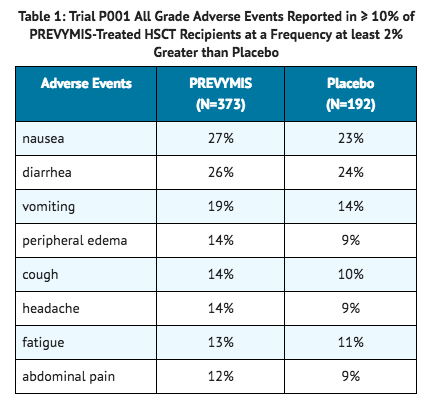
- Overall, similar proportions of subjects in each group discontinued study medication due to an adverse event (13% of letermovir subjects vs. 12% of placebo subjects). The most frequently reported adverse event that led to study drug discontinuation was nausea, occurring in 2% of letermovir subjects and 1% of placebo subjects. Hypersensitivity reaction, with associated moderate dyspnea, occurred in one subject following the first infusion of IV letermovir after switching from oral letermovir, leading to treatment discontinuation.
Laboratory Abnormalities
- Selected laboratory abnormalities reported during treatment or within 2 weeks of stopping treatment are presented in the table below.

- The median time to engraftment (defined as absolute neutrophil count ≥ 500/mm3 on 3 consecutive days after transplantation) was 19 days in the letermovir group and 18 days in the placebo group.
Postmarketing Experience
There is limited information regarding Letermovir Postmarketing Experience in the drug label.
Drug Interactions
- Potential for Other Drugs to Affect Letermovir
- Potential for Letermovir to Affect Other Drugs
- Established and Other Potentially Significant Drug Interactions
- Drugs without Clinically Significant Interactions with Letermovir
Potential for Other Drugs to Affect Letermovir
- Letermovir is a substrate of organic anion-transporting polypeptide 1B1/3 (OATP1B1/3) transporters. Co-administration of letermovir with drugs that are inhibitors of OATP1B1/3 transporters may result in increases in letermovir plasma concentrations.
Potential for Letermovir to Affect Other Drugs
- Co-administration of letermovir with midazolam results in increased midazolam plasma concentrations, indicating that letermovir is a moderate inhibitor of CYP3A. Co-administration of letermovir with drugs that are CYP3A substrates may result in clinically relevant increases in the plasma concentrations of co-administered CYP3A substrates.
- Letermovir is an inhibitor of OATP1B1/3 transporters. Co-administration of letermovir with drugs that are substrates of OATP1B1/3 transporters may result in a clinically relevant increase in plasma concentrations of co-administered OATP1B1/3 substrates.
- The magnitude of CYP3A- and OATP1B1/3-mediated drug interactions on co-administered drugs may be different when letermovir is co-administered with cyclosporine. See the prescribing information for cyclosporine for information on drug interactions with cyclosporine.
Established and Other Potentially Significant Drug Interactions
- If dose adjustments of concomitant medications are made due to treatment with letermovir, doses should be readjusted after treatment with letermovir is completed.
- Table 3 provides a listing of established or potentially clinically significant drug interactions. The drug interactions described are based on studies conducted with letermovir or are predicted drug interactions that may occur with letermovir.

Drugs without Clinically Significant Interactions with Letermovir
- No clinically significant interactions were observed in clinical drug-drug interaction studies of letermovir and acyclovir, digoxin, mycophenolate mofetil, posaconazole, ethinyl estradiol, and levonorgestrel.
Use in Specific Populations
Pregnancy
Risk Summary
- No adequate human data are available to establish whether letermovir poses a risk to pregnancy outcomes. In animal reproduction studies, embryo-fetal developmental toxicity (including fetal malformations) was observed in rats during the period of organogenesis at letermovir exposures (AUC) 11 times higher than human exposure at the recommended human dose (RHD). In rabbits, no embryo-fetal developmental toxicity was noted at exposures that were not maternally toxic (up to letermovir exposures 2 times higher than human exposure at the RHD). In a rat pre/post-natal development study, total litter loss was observed at maternal letermovir exposures approximately 2 times higher than human exposure at the RHD.
- The background risk of major birth defects and miscarriage for the indicated population is unknown. In the U.S. general population, the estimated background risk of major birth defects and miscarriage in clinically recognized pregnancies is 2-4% and 15-20%, respectively.
Data (Animal)
- Letermovir was administered orally to pregnant rats at 0, 10, 50 or 250 mg/kg/day from gestation days 6 to 17. Developmental toxicities, including skeletal malformations and umbilical cord shortening, were observed at 250 mg/kg/day (approximately 11 times higher than human exposure at the RHD). In addition, decreased fetal body weight and skeletal variations (due to maternal toxicity) were observed at this dose. No embryo-fetal toxicities were observed at 50 mg/kg/day (approximately 3 times higher than human exposure at the RHD).
- Letermovir was administered orally to pregnant rabbits at 0, 25, 75 or 225 mg/kg/day from gestation days 6 to 20. Developmental toxicities, including spontaneous abortion, increased post-implantation loss, and skeletal variations, were observed at a maternally toxic dose (225 mg/kg/day; approximately 2 times higher than human exposure at the RHD). No embryo-fetal toxicities were observed at 75 mg/kg/day (less than human exposure at the RHD).
- In the pre/post-natal development study, letermovir was administered orally to pregnant rats at 0, 10, 45 or 180 mg/kg/day from gestation day 6 to lactation day 22. At 180 mg/kg/day (approximately 2 times higher than human exposure at the RHD), total litter loss due to stillbirth or possible maternal neglect was observed in 5 of 23 pregnant females by post-partum/lactation day 4. In surviving offspring, slight developmental delays in vaginal opening and pinna unfolding were accompanied by reduced body weight gain at this dose. No toxicities were observed at 45 mg/kg/day (similar to human exposure at the RHD).
Pregnancy Category (AUS):
There is no Australian Drug Evaluation Committee (ADEC) guidance on usage of Letermovir in women who are pregnant.
Labor and Delivery
There is no FDA guidance on use of Letermovir during labor and delivery.
Nursing Mothers
Risk Summary
- It is not known whether letermovir is present in human breast milk, affects human milk production, or has effects on the breastfed child.
- When administered to lactating rats, letermovir was present in the milk of lactating rats as well as the blood of nursing pups.
- The developmental and health benefits of breastfeeding should be considered along with the mother's clinical need for letermovir and any potential adverse effects on the breastfed child from letermovir or from the underlying maternal condition.
Data
- In a lactation study, letermovir was excreted in milk when administered intravenously (at 10 mg/kg) to lactating rats on post-partum/lactation day 10. Letermovir was also detected in the blood of nursing pups on post-partum/lactation day 21 in the pre/post-natal developmental study.
Pediatric Use
- Safety and efficacy of letermovir in patients below 18 years of age have not been established.
Geriatic Use
- Of the 373 subjects treated with letermovir in Trial P001, 56 (15%) subjects were 65 years of age or older. Safety and efficacy were similar across older and younger subjects. No dosage adjustment of letermovir is required based on age.
Gender
There is no FDA guidance on the use of Letermovir with respect to specific gender populations.
Race
There is no FDA guidance on the use of Letermovir with respect to specific racial populations.
Renal Impairment
- For patients with CLcr greater than 10 mL/min (by Cockcroft-Gault equation), no dosage adjustment of letermovir is required based on renal impairment. The safety of letermovir in patients with end-stage renal disease (CLcr less than 10 mL/min), including patients on dialysis, is unknown.
- In patients with CLcr less than 50 mL/min receiving letermovir injection, accumulation of the intravenous vehicle, hydroxypropyl betadex, could occur. Closely monitor serum creatinine levels in these patients.
Hepatic Impairment
- No dosage adjustment of letermovir is required for patients with mild (Child-Pugh Class A) or moderate (Child-Pugh Class B) hepatic impairment. Letermovir is not recommended for patients with severe (Child-Pugh Class C) hepatic impairment.
Females of Reproductive Potential and Males
Infertility
- There are no data on the effect of letermovir on human fertility. Decreased fertility due to testicular toxicity was observed in male rats.
Immunocompromised Patients
There is no FDA guidance one the use of Letermovir in patients who are immunocompromised.
Administration and Monitoring
Administration
Important Dosing and Administration Information
- Letermovir Tablets
- Administer with or without food.
- Swallow tablets whole.
- Letermovir Injection
- Administer by intravenous infusion via a peripheral catheter or central venous line at a constant rate over 1 hour.
- Do not administer as an intravenous bolus injection.
Preparation and Administration of Intravenous Solution
- Letermovir injection is supplied in 30 mL single-dose vials containing either 240 mg/12 mL per vial (20 mg/mL) or 480 mg/24 mL per vial (20 mg/mL). The preparation and administration instructions are the same for either dose.
- Letermovir vials are for single use only. Discard any unused portion.
Preparation and Administration Instructions
- Letermovir must be diluted prior to intravenous (IV) use.
- Inspect vial contents for discoloration and particulate matter prior to dilution. Letermovir injection is a clear colorless solution. Do not use the vial if the solution is discolored or contains visible particles.
- Do not shake letermovir vial.
- Add one single-dose vial of letermovir injection into a 250 mL pre-filled IV bag containing either 0.9% Sodium Chloride Injection, USP or 5% Dextrose Injection, USP and mix bag gently. Do not shake. Only 0.9% Sodium Chloride and 5% Dextrose are chemically and physically compatible with letermovir injection.
- Use compatible IV bags and infusion set materials. Letermovir injection is compatible with the following IV bags and infusion set materials. Letermovir injection is not recommended with any IV bags or infusion set materials not listed below (note that letermovir injection is not recommended for use with polyurethane-containing IV administration set tubing).
- IV Bags Materials:
- Polyvinyl chloride (PVC), ethylene vinyl acetate (EVA) and polyolefin (polypropylene and polyethylene)
- Infusion Sets Materials:
- PVC, polyethylene (PE), polybutadiene (PBD), silicone rubber (SR), styrene–butadiene copolymer (SBC), styrene-butadiene-styrene copolymer (SBS), polystyrene (PS)
- Plasticizers:
- Diethylhexyl phthalate (DEHP), tris (2-ethylhexyl) trimellitate (TOTM), benzyl butyl phthalate (BBP)
- Catheters:
- Radiopaque polyurethane
- Once diluted, the solution of letermovir is clear, and ranges from colorless to yellow. Variations of color within this range do not affect the quality of the product. Parenteral drug products should be inspected visually for particulate matter and discoloration prior to administration, whenever solution and container permit. Discard if discoloration or visible particles are observed.
- The diluted solution is stable for up to 24 hours at room temperature or up to 48 hours under refrigeration at 2°C to 8°C (36°F to 46°F) (this time includes storage of the diluted solution in the intravenous bag through the duration of infusion).
- Administer the entire contents of the intravenous bag by intravenous infusion via a peripheral catheter or central venous line at a constant rate over 1 hour.
Compatible Drug Products Used for Intravenous Administration
Compatible Drug Products
- The physical compatibility of letermovir injection with selected injectable drug products was evaluated in two commonly available diluents. Letermovir should not be co-administered through the same intravenous line (or cannula) with other drug products and diluent combinations except those listed below. Refer to the respective prescribing information of the co-administered drug(s) to confirm compatibility of simultaneous co-administration.
List of Compatible Drug Products when Letermovir and Drug Products are Prepared in 0.9% Sodium Chloride Injection, USP:
- Ampicillin sodium, ampicillin sodium/sulbactam sodium, anti-thymocyte globulin, caspofungin, daptomycin, fentanyl citrate, fluconazole, furosemide, human insulin, magnesium sulfate, methotrexate, micafungin.
List of Compatible Drug Products when Letermovir and Drug Products are Prepared in 5% Dextrose Injection, USP:
- Amphotericin B (lipid complex)1, anidulafungin, cefazolin sodium, ceftaroline, ceftriaxone sodium, doripenem, famotidine, folic acid, ganciclovir sodium, hydrocortisone sodium succinate, morphine sulfate, norepinephrine bitartrate, pantoprazole sodium, potassium chloride, potassium phosphate, tacrolimus, telavancin, tigecycline.
- 1= Amphotericin B (lipid complex) is compatible with letermovir. However, Amphotericin B (liposomal) is incompatible.
Incompatible Drug Products for Intravenous Administration
Incompatible Drug Products
- Letermovir injection is physically incompatible with amiodarone hydrochloride, amphotericin B (liposomal), aztreonam, cefepime hydrochloride, ciprofloxacin, cyclosporine, diltiazem hydrochloride, filgrastim, gentamicin sulfate, levofloxacin, linezolid, lorazepam, midazolam HCl, mycophenolate mofetil hydrochloride, ondansetron, palonosetron.
Monitoring
- Following the completion of letermovir prophylaxis, monitoring for CMV reactivation is recommended.
- Prophylaxis of clinically significant cytomegalovirus infection is indicative of efficacy.
- Serum creatinine levels: Closely in patients with CrCl less than 50 mL/min receiving IV formulation.
- Reactivation of cytomegalovirus.
IV Compatibility
There is limited information regarding the compatibility of Letermovir and IV administrations.
Overdosage
- There is no specific antidote for overdose with letermovir. In case of overdose, it is recommended that the patient be monitored for adverse reactions and appropriate symptomatic treatment be instituted.
- It is unknown whether dialysis will result in meaningful removal of letermovir from systemic circulation.
Pharmacology
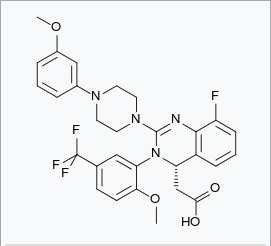
| |
Letermovir
| |
| Systematic (IUPAC) name | |
| {(4S)-8-Fluoro-2-[4-(3-methoxyphenyl)-1-piperazinyl]-3-[2-methoxy-5-(trifluoromethyl)phenyl]-3,4-dihydro-4-quinazolinyl}acetic acid | |
| Identifiers | |
| CAS number | ? |
| ATC code | None |
| PubChem | |
| Chemical data | |
| Formula | Template:OrganicBox atomTemplate:OrganicBox atomTemplate:OrganicBoxTemplate:OrganicBoxTemplate:OrganicBoxTemplate:OrganicBoxTemplate:OrganicBoxTemplate:OrganicBoxTemplate:OrganicBox atomTemplate:OrganicBoxTemplate:OrganicBoxTemplate:OrganicBoxTemplate:OrganicBoxTemplate:OrganicBox atomTemplate:OrganicBoxTemplate:OrganicBox atomTemplate:OrganicBoxTemplate:OrganicBoxTemplate:OrganicBoxTemplate:OrganicBoxTemplate:OrganicBoxTemplate:OrganicBoxTemplate:OrganicBox |
| Mol. mass | ? |
| SMILES | & |
| Synonyms | AIC246; MK-8228 |
| Pharmacokinetic data | |
| Bioavailability | ? |
| Metabolism | ? |
| Half life | ? |
| Excretion | ? |
| Therapeutic considerations | |
| Pregnancy cat. |
? |
| Legal status |
[[Prescription drug|Template:Unicode-only]](US) |
| Routes | Oral |
Mechanism of Action
- Letermovir is an antiviral drug against CMV.
Structure
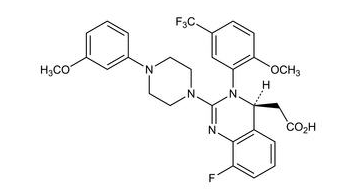
Pharmacodynamics
Cardiac Electrophysiology
- In a thorough QT trial in healthy subjects, letermovir at the therapeutic IV dose or at a dose of 2 times the approved IV dose did not prolong QTc to any clinically relevant extent.
Pharmacokinetics
- The pharmacokinetic properties of letermovir are displayed in Table 4.

Specific Populations
Pediatric Population
- The pharmacokinetics of letermovir in patients less than 18 years of age have not been evaluated.
Age, Gender, Race, and Weight
- Age (18 to 78 years), gender, race (White vs. non-White), and body weight (up to 100 kg) did not have a clinically significant effect on the pharmacokinetics of letermovir.
Renal Impairment
- Letermovir AUC was approximately 1.9- and 1.4-fold higher in subjects with moderate (eGFR greater than or equal to 30 to 59 mL/min/1.73m2) and severe (eGFR less than 30 mL/min/1.73m2) renal impairment, respectively, compared to healthy subjects.
- Hydroxypropyl betadex present in the intravenous letermovir formulation is mainly eliminated by glomerular filtration. Decreased elimination of hydroxypropyl betadex has been reported in the literature in patients with severe renal impairment.
Hepatic Impairment
- Letermovir AUC was approximately 1.6- and 3.8-fold higher in subjects with moderate (Child-Pugh Class B [CP-B], score of 7-9) and severe (Child-Pugh Class C [CP-C], score of 10-15) hepatic impairment, respectively, compared to healthy subjects.
Drug Interaction Studies
- Drug interaction studies were performed in healthy subjects with letermovir and drugs likely to be co-administered or drugs commonly used as probes for pharmacokinetic interactions.
- In vitro results indicate that letermovir is a substrate of drug metabolizing enzymes CYP3A, CYP2D6, UGT1A1, and UGT1A3, and transporters OATP1B1/3 and P-gp. Oxidative metabolism is considered to be a minor elimination pathway based on in vivo human data. Inhibitors of OATP1B1/3 may result in increases in letermovir plasma concentrations. Changes in letermovir plasma concentrations due to inhibition of P-gp or UGTs are not anticipated to be clinically relevant.
- Based on in vitro studies, the metabolism of letermovir is not mediated by CYP1A2, CYP2A6, CYP2B6, CYP2C8, CYP2C9, CYP2C18, CYP2C19, CYP2E1, CYP4A11, UGT1A4, UGT1A6, UGT1A7, UGT1A8, UGT1A9, UGT1A10, UGT2B4, UGT2B7, UGT2B15, or UGT2B17. The transport of letermovir is not mediated by OATP2B1, OCT1, OAT1, BCRP, or MRP2 in vitro.
- Letermovir is a time-dependent inhibitor and inducer of CYP3A in vitro. Co-administration of letermovir with midazolam resulted in increased exposure of midazolam, indicating that the net effect of letermovir on CYP3A is moderate inhibition. Based on these results, co-administration of letermovir with CYP3A substrates may increase the plasma concentrations of the CYP3A substrates. Letermovir is a reversible inhibitor of CYP2C8 in vitro. When co-administered with letermovir, plasma concentrations of CYP2C8 substrates are predicted to be increased. Co-administration of letermovir reduced the exposure of voriconazole, most likely due to the induction of voriconazole elimination pathways, CYP2C9 and CYP2C19. Co-administration of letermovir with CYP2C9 and CYP2C19 substrates may decrease the plasma concentrations of the CYP2C9 and CYP2C19 substrates. Letermovir is an inducer of CYP2B6 in vitro; the clinical relevance is unknown.
- Letermovir inhibited efflux transporters P-gp, breast cancer resistance protein (BCRP), bile salt export pump (BSEP), multidrug resistance-associated protein 2 (MRP2), OAT3, and hepatic uptake transporter OATP1B1/3 in vitro. Co-administration of letermovir with substrates of OATP1B1/3 transporters (e.g. atorvastatin, a known substrate of CYP3A, OATP1B1/3, and potentially BCRP) may result in a clinically relevant increase in plasma concentrations of OATP1B1/3 substrates. There were no clinically relevant changes in plasma concentrations of digoxin, a P-gp substrate, or acyclovir, an OAT3 substrate, following co-administration with letermovir in clinical studies. The effect of letermovir on BCRP, BSEP, and MRP2 substrates was not evaluated in clinical studies; the clinical relevance is unknown.
- Based on in vitro results letermovir is not an inhibitor of CYP1A2, CYP2A6, CYP2C9, CYP2C19, CYP2D6, CYP2E1, UGT1A4, UGT1A6, UGT1A9, or UGT2B7 and is not an inducer of CYP1A2. Letermovir is not an inhibitor of MRP2, OATP2B1, BSEP, OCT1, OCT2, or OAT1 in vitro.
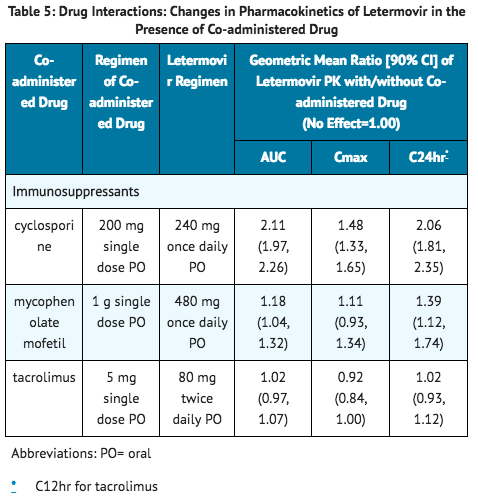
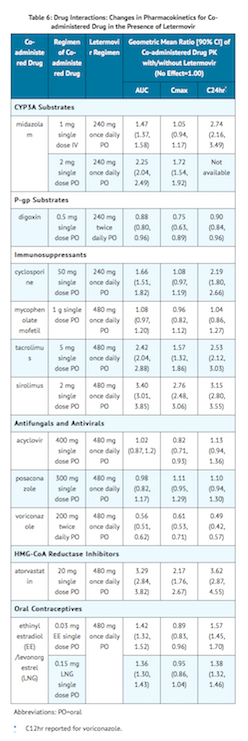
Microbiology
Mechanism of Action
- Letermovir inhibits the CMV DNA terminase complex (pUL51, pUL56, and pUL89) which is required for viral DNA processing and packaging. Biochemical characterization and electron microscopy demonstrated that letermovir affects the production of proper unit length genomes and interferes with virion maturation. Genotypic characterization of virus resistant to letermovir confirmed that letermovir targets the terminase complex.
Antiviral Activity
- The median EC50 value of letermovir against a collection of clinical CMV isolates in a cell-culture model of infection was 2.1 nM (range = 0.7 nM to 6.1 nM, n = 74). There was no significant difference in EC50 value by CMV gB genotype (gB1=29; gB2=27; gB3=11; and gB4=3).
Combination Antiviral Activity
- No antagonism of the antiviral activity was seen when letermovir was combined with CMV DNA polymerase inhibitors (cidofovir, foscarnet, or ganciclovir).
Viral Resistance
In Cell Culture
- CMV mutants with reduced susceptibility to letermovir have been selected in cell culture and the resistance mutations map to UL56. Resistance-associated substitutions occur between amino acid positions pUL56 231 and 369 (V231A/L, V236L/M, E237D, L241P, T244K/R, L257I, F261C/L/S, Y321C, C325F/R/Y, M329T, R369G/M/S). EC50 values for virus expressing these substitutions are 13- to 5,870-fold higher than those for the wild-type reference virus.
In Clinical Studies
- In a Phase 2b trial evaluating letermovir or placebo in 131 HSCT recipients, DNA sequence analysis of a select region of UL56 (amino acids 231 to 369) was performed on samples obtained from 12 letermovir-treated subjects who experienced prophylaxis failure and for whom on-treatment samples were available for analysis. One subject had a letermovir resistance substitution, pUL56 V236M.
- In a Phase 3 trial (P001), DNA sequence analysis of the entire coding regions of UL56 and UL89 was performed on samples obtained from 28 letermovir-treated subjects who had received at least one dose of study drug and experienced prophylaxis failure and for whom samples were available for analysis. Two subjects were identified as having a letermovir-resistance substitution, pUL56 V236M or C325W. These substitutions were identified from on-treatment samples. A virus from a third subject who experienced prophylaxis failure had a pUL56 E237G substitution at low frequency (<5%), and while pUL56 E237D was associated with resistance in cell culture, the clinical significance of this substitution at this frequency is unknown.
Cross Resistance
- Cross resistance is not likely with drugs outside of this class. Letermovir is fully active against viral populations with substitutions conferring resistance to CMV DNA polymerase inhibitors (cidofovir, foscarnet, and ganciclovir). These DNA polymerase inhibitors are fully active against viral populations with substitutions conferring resistance to letermovir.
Nonclinical Toxicology
Carcinogenesis, Mutagenesis, Impairment of Fertility
Carcinogenesis and Mutagenesis
- Letermovir was not genotoxic in in vitro or in vivo assays, including microbial mutagenesis assays, chromosomal aberration in Chinese hamster ovary cells, and in an in vivo mouse micronucleus study.
- Carcinogenicity studies with letermovir have not been conducted.
Impairment of Fertility
- In a fertility and early embryonic development study in rats, no effects of letermovir on female fertility were observed at letermovir exposures (AUC) approximately 5 times higher than human exposure at the RHD.
- In male rat fertility studies, decreased fertility associated with irreversible testicular toxicity was observed at ≥180 mg/kg/day (greater than or equal to 3 times the human exposure at the RHD). No fertility or testicular effects were observed at dose levels resulting in letermovir exposures (AUC) similar to human exposure at the RHD.
Animal Toxicology and/or Pharmacology
- Testicular toxicity in rats observed at ≥180 mg/kg/day (greater than or equal to 3 times the human exposure at the RHD) was characterized by decreased testis weight, bilateral seminiferous tubular degeneration, decreased sperm count and motility, and resultant decreased male fertility. Male reproductive system toxicities were not observed in either a monkey testicular toxicity study up to 240 mg/kg/day (approximately 2 times higher than human exposure at the RHD), or a general toxicology study in mice up to 250 mg/kg/day (approximately 3 times higher than human exposure at the RHD).
Clinical Studies
Adult CMV-seropositive Recipients [R+] of an Allogeneic Hematopoietic Stem Cell Transplant
- To evaluate letermovir prophylaxis as a preventive strategy for CMV infection or disease in transplant recipients at high risk for CMV reactivation, the efficacy of letermovir was assessed in a multicenter, double-blind, placebo-controlled Phase 3 Trial (P001, NCT02137772) in adult CMV-seropositive recipients [R+] of an allogeneic hematopoietic stem cell transplant (HSCT). Subjects were randomized (2:1) to receive either letermovir at a dose of 480 mg once daily adjusted to 240 mg when co-administered with cyclosporine, or placebo. Randomization was stratified by investigational site and risk level for CMV reactivation at the time of study entry. Study drug was initiated after HSCT (at any time from Day 0 to Day 28 post-transplant) and continued through Week 14 post-transplant. Study drug was administered either orally or intravenously; the dose of letermovir was the same regardless of the route of administration. Subjects received CMV DNA monitoring weekly until post-transplant Week 14 and then bi-weekly until post-transplant Week 24, with initiation of standard-of-care CMV pre-emptive therapy if CMV viremia was considered clinically significant. Subjects had continued follow-up through Week 48 post-transplant.
- Among the 565 treated subjects, 70 subjects were found to have CMV viremia prior to study drug initiation and were therefore excluded from the efficacy analyses. The efficacy population consisted of 325 subjects who received letermovir (including 91 subjects who received at least one IV dose) and 170 who received placebo (including 41 subjects who received at least one IV dose). The IV formulation of letermovir was used at investigators' discretion in subjects who were unable to take oral therapy (e.g., unable to tolerate oral intake). The median time to starting study drug was 8 days after transplantation. Thirty-four percent (34%) of subjects were engrafted at baseline. The median age was 55 years (range: 18 to 76 years); 57% were male; 84% were White; 9% were Asian; 2% were Black or African American; and 7% were Hispanic or Latino.
- At baseline, 30% of all subjects had one or more of the following factors associated with increased risk for CMV reactivation (high risk stratum): Human Leukocyte Antigen (HLA)-related donor with at least one mismatch at one of the following three HLA-gene loci: HLA-A, -B or –DR; haploidentical donor; unrelated donor with at least one mismatch at one of the following four HLA-gene loci: HLA-A, -B, -C and -DRB1; use of umbilical cord blood as stem cell source; use of ex vivo T-cell-depleted grafts; Grade 2 or greater Graft-Versus-Host Disease (GVHD) requiring systemic corticosteroids. The remaining 70% of subjects did not meet any of these high risk stratum criteria and were therefore included in the low risk stratum. Additionally, 48% of subjects received a myeloablative regimen, 51% were receiving cyclosporine, and 43% were receiving tacrolimus. The most common primary reasons for transplant were acute myeloid leukemia (38%), myelodysplastic syndrome (16%), and lymphoma (12%).
Clinically Significant CMV Infection
- The primary efficacy endpoint of Trial P001 was the incidence of clinically significant CMV infection through Week 24 post-transplant (prophylaxis failure). Clinically significant CMV infection was defined as the occurrence of either CMV end-organ disease, or initiation of anti-CMV pre-emptive therapy (PET) based on documented CMV viremia (using the Roche COBAS® AmpliPrep/COBAS TaqMan® assay, LLoQ is 137 IU/mL, which is approximately 150 copies/mL) and the clinical condition of the subject. The protocol-specified guidance for CMV DNA thresholds for the initiation of PET during the treatment period was ≥ 150 copies/mL or > 300 copies/mL for subjects in the high and low risk strata, respectively. From Week 14 through Week 24, the threshold was >300 copies/mL for both high and low risk strata subjects. The Non-Completer=Failure (NC=F) approach was used, where subjects who discontinued from the trial prior to Week 24 post-transplant or had a missing outcome at Week 24 post-transplant were counted as failures.
- Efficacy results from Trial P001 are shown in Table 7.
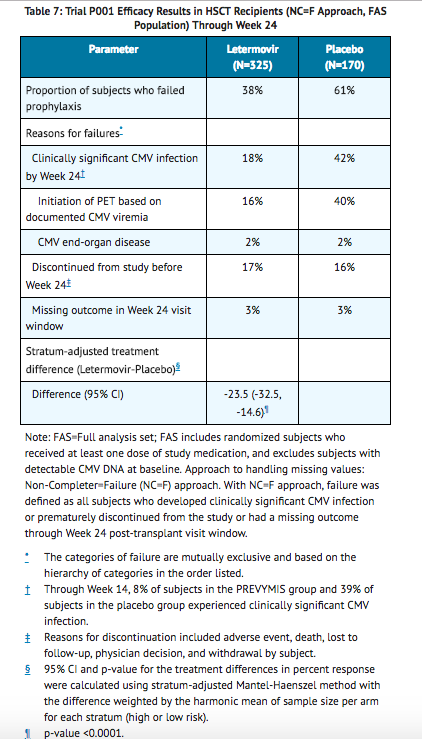
- Efficacy results were consistent across high and low risk strata for CMV reactivation. The time to clinically significant CMV infection is shown in Figure 1.
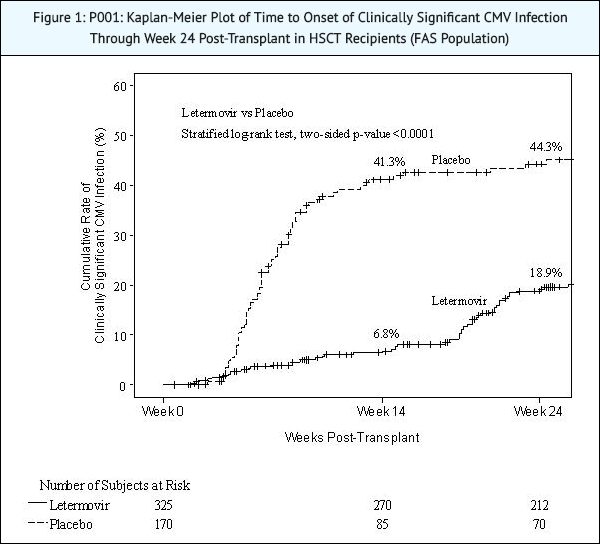
- Post-hoc analysis demonstrated that among letermovir-treated subjects, inclusion in the high risk stratum for CMV reactivation at baseline, occurrence of GVHD, and steroid use at any time after randomization may be associated with the development of clinically significant CMV infection between Week 14 and Week 24 post-transplant.
Mortality
- The Kaplan-Meier event rate for all-cause mortality in the letermovir vs. placebo groups was 12% vs. 17% at Week 24 post-transplant, and 24% vs. 28% at Week 48 post-transplant.
How Supplied
Tablets
- Each letermovir 240 mg tablet is a yellow oval tablet; each tablet is debossed with "591" on one side and Merck logo on the other side. Each letermovir 480 mg tablet is a pink oval, bi-convex tablet debossed with "595" on one side and Merck logo on the other side.
- The 240 mg tablets are packaged into a carton (NDC 0006-3075-02) containing four (4) Child Resistant (CR) Dosepaks®, each containing a 7-count blister card for a total of 28 tablets, or into a carton (NDC 0006-3075-04) containing two (2) unit-dose 7-count blister cards for a total of 14 tablets.
- The 480 mg tablets are packaged into a carton (NDC 0006-3076-02) containing four (4) Child Resistant (CR) Dosepaks®, each containing a 7-count blister card for a total of 28 tablets, or into a carton (NDC 0006-3076-04) containing two (2) unit-dose 7-count blister cards for a total of 14 tablets.
Injection
- Letermovir is supplied as a sterile, clear solution for intravenous use of 240 mg (12 mL per vial) or 480 mg (24 mL per vial). The final solutions for infusion are obtained by dilution with 0.9% Sodium Chloride Injection, USP or 5% Dextrose Injection, USP.
- The single dose vials are supplied in cartons that contain a 240 mg single-dose vial (NDC 0006-5003-01) or a 480 mg single-dose vial (NDC 0006-5004-01).
Storage
Tablets
- Store letermovir tablets in the original package until use.
- Store letermovir tablets at 20°C to 25°C (68°F to 77°F); excursions permitted to 15°C to 30°C (59°F to 86°F).
Injection
- Store letermovir injection vials at 20°C to 25°C (68°F to 77°F); excursions permitted to 15°C to 30°C (59°F to 86°F).
- Store in the original carton to protect from exposure to light.
Images
Drug Images
{{#ask: Page Name::Letermovir |?Pill Name |?Drug Name |?Pill Ingred |?Pill Imprint |?Pill Dosage |?Pill Color |?Pill Shape |?Pill Size (mm) |?Pill Scoring |?NDC |?Drug Author |format=template |template=DrugPageImages |mainlabel=- |sort=Pill Name }}
Package and Label Display Panel


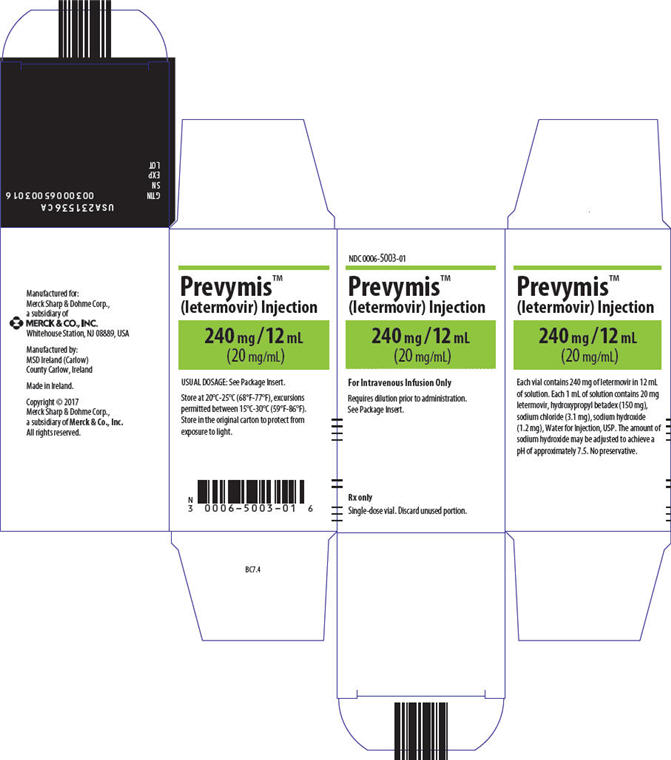
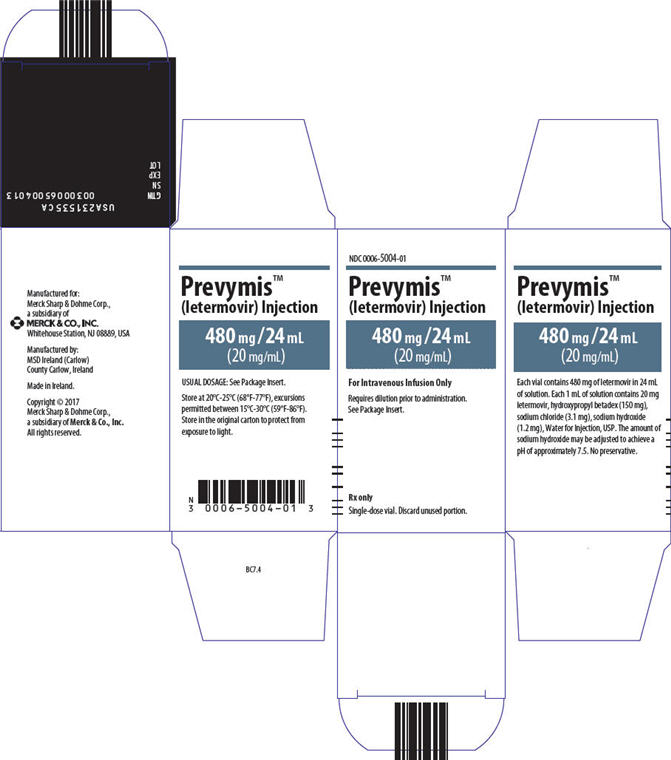
{{#ask: Label Page::Letermovir |?Label Name |format=template |template=DrugLabelImages |mainlabel=- |sort=Label Page }}
Patient Counseling Information
- Advise the patient to read the FDA-approved patient labeling (Patient Information).
Drug Interactions
- Inform patients that letermovir may interact with some drugs; therefore, advise patients to report the use of any prescription, non-prescription medication, or herbal products to their healthcare provider.
Administration
- Inform patients that it is important not to miss or skip doses and to take letermovir for the duration that is recommended by the healthcare provider. Instruct patients that if they miss a dose of letermovir, they should take it as soon as they remember. If they do not remember until it is time for the next dose, instruct them to skip the missed dose and go back to the regular schedule. Instruct patients not to double their next dose or take more than the prescribed dose.
Storage
- Advise patients to store letermovir tablets in the original package until use.
Precautions with Alcohol
Alcohol-Letermovir interaction has not been established. Talk to your doctor regarding the effects of taking alcohol with this medication.
Brand Names
- Prevymis
Look-Alike Drug Names
There is limited information regarding Letermovir Look-Alike Drug Names in the drug label.
Drug Shortage Status
Drug Shortage
Price
References
The contents of this FDA label are provided by the National Library of Medicine.